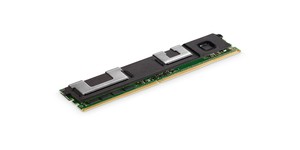Intel has announced the the impending launch of its first Optane product, a high-performance PCI Express add-in board for servers and high-performance computers (HPCs).
Intel announced Optane back in 2015 as the brand name for its implementation of 3D XPoint solid-state memory, developed in partnership with Micron, and pledged that it would hit the market the very next year as a high-performance replacement for traditional NAND flash and a non-volatile alternative to dynamic RAM (DRAM). Sadly, 2016 came and went with no sign of Optane products, but the company confirmed it wasn't dead in February this year with the announcement of system requirements for its upcoming server- and consumer-centric implementations.
Now, Intel is confident enough in its product that it has finally begun shipping its first Optane product - albeit exclusively to carefully-selected partners in what the company calls an 'early ship programme' ahead of a vague 2H 2017 roll-out plan. The Intel Optane SSD DC P4800X, to give the device its full title, is a PCI Express-connected Optane solid-state drive packing 375GB of high-performance storage. While it's entirely possible to use this as direct low-latency storage, Intel has explained, the performance of Optane is high enough that it can also be used with what the company has called Intel Memory Drive Technology in order to masquerade as DRAM - meaning a server equipped with an Optane P4800X board and 64GB of DRAM would appear to have 439GB of usable memory.
Sadly, this functionality isn't as flexible as it first sounds, in Optane's initial outing at least: Intel is launching two distinct products, the Intel Optane SSD DC P4800X and the Intel Optane SSD DC P4800X with Intel Memory Drive Technology. The former will act only as an SSD, though it would be possible to install a swapfile onto the drive in order to use it as high-speed RAM-like temporary storage or to configure it as a cache layer between DRAM and mass storage; the latter, meanwhile, will act only as pseudo-DRAM with no option to reconfigure it for storage or caching at a later date.
Intel has claimed that the initial 375GB Optane implementation has a latency below 10 microseconds, throughput of 550,000 4K random read input-output operations per second (IOPS) and 500,000 4K random write IOPS, though has not yet detailed peak throughput in gigabytes per second. More information is available on the official product page.
Intel announced Optane back in 2015 as the brand name for its implementation of 3D XPoint solid-state memory, developed in partnership with Micron, and pledged that it would hit the market the very next year as a high-performance replacement for traditional NAND flash and a non-volatile alternative to dynamic RAM (DRAM). Sadly, 2016 came and went with no sign of Optane products, but the company confirmed it wasn't dead in February this year with the announcement of system requirements for its upcoming server- and consumer-centric implementations.
Now, Intel is confident enough in its product that it has finally begun shipping its first Optane product - albeit exclusively to carefully-selected partners in what the company calls an 'early ship programme' ahead of a vague 2H 2017 roll-out plan. The Intel Optane SSD DC P4800X, to give the device its full title, is a PCI Express-connected Optane solid-state drive packing 375GB of high-performance storage. While it's entirely possible to use this as direct low-latency storage, Intel has explained, the performance of Optane is high enough that it can also be used with what the company has called Intel Memory Drive Technology in order to masquerade as DRAM - meaning a server equipped with an Optane P4800X board and 64GB of DRAM would appear to have 439GB of usable memory.
Sadly, this functionality isn't as flexible as it first sounds, in Optane's initial outing at least: Intel is launching two distinct products, the Intel Optane SSD DC P4800X and the Intel Optane SSD DC P4800X with Intel Memory Drive Technology. The former will act only as an SSD, though it would be possible to install a swapfile onto the drive in order to use it as high-speed RAM-like temporary storage or to configure it as a cache layer between DRAM and mass storage; the latter, meanwhile, will act only as pseudo-DRAM with no option to reconfigure it for storage or caching at a later date.
Intel has claimed that the initial 375GB Optane implementation has a latency below 10 microseconds, throughput of 550,000 4K random read input-output operations per second (IOPS) and 500,000 4K random write IOPS, though has not yet detailed peak throughput in gigabytes per second. More information is available on the official product page.

MSI MPG Velox 100R Chassis Review
October 14 2021 | 15:04










Want to comment? Please log in.